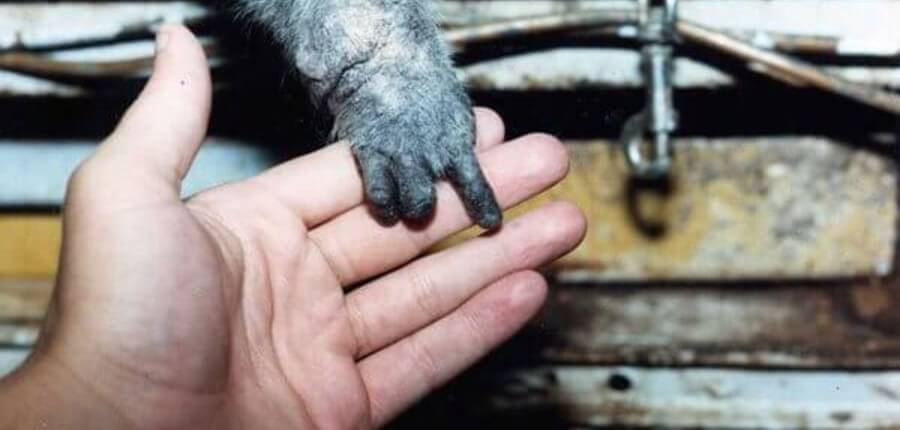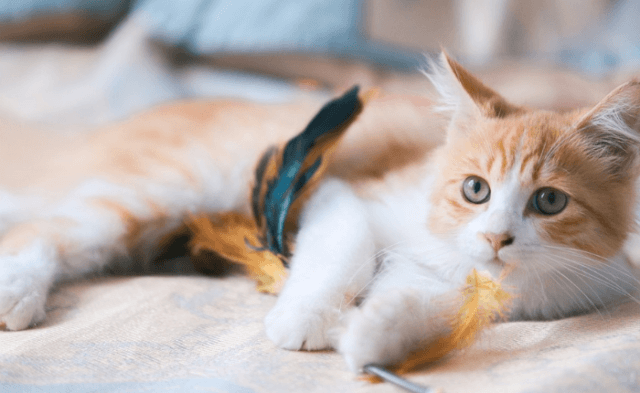In 1981, PETA’s founder Ingrid Newkirk browsed a list of the U.S. Department of Agriculture’s laboratories. She located the Institute for Behavioral Research (IBR) in Silver Spring, Maryland, and asked her colleague Alex Pacheco if he could get inside.
Alex accessed the federally funded institution as a volunteer, simply to find out how laboratories run—only to find 17 traumatized macaque monkeys imprisoned in appalling conditions inside. They had been snatched from their homes and families and were huddled in filthy, feces-encrusted cages, nursing maimed and bloodied limbs and missing fingers. One monkey, Sarah, had suffered for eight years inside the same cage.
Experimenter Edward Taub had cut their spinal cords, rendering one arm useless. He then strapped them into homemade restraints—including a converted refrigerator with blood smeared on its walls—and tormented monkeys with electroshocks, burned them with cigarette lighters, and squeezed their sensitive skin and testicles with pliers to try to force them to use their useless limbs.
Food thrown into their cages fell through the wire floors onto feces below, and the monkeys were forced to pick up soiled food with their one good hand. One of them, named Billy, couldn’t use either arm and was forced to push himself on his elbows across the cage grating to eat his food by grasping it between his teeth, which were painfully infected. The monkeys’ usually lustrous hair was missing—lost in clumps from malnutrition and pulled out in distress.
Because the monkeys couldn’t feel their arms, they sometimes attacked them and even chewed off their own fingers. Wounds were crudely dressed in rotting bandages. One monkey, Paul, had a bandage that had never been changed. Many others lost fingers by getting them caught on the rusty wires of their cages.
PETA comprehensively documented these instances of abuse and brought evidence to the police. This led to several significant firsts: the nation’s first arrest and criminal conviction of an animal experimenter for cruelty to animals, the first time abused animals were confiscated from a laboratory, and the first U.S. Supreme Court victory for animals used in experiments. It prompted new additions to the federal Animal Welfare Act, and the institute was shut down. Several of the monkeys were moved to an enclosure at the San Diego Zoo, where they were able to live in peace.
However, not all the animals removed from the IBR enjoyed the happy lives we had envisioned for them. Even though PETA along with numerous senators and congress members worked to free the monkeys for years, the government refused to allow this “win” and turned them over to laboratories, where they were eventually subjected to one final experiment and then killed. One of these monkeys, Augustus, is memorialized in the name of PETA’s Augustus Club. This is a community of donors that honors his stoic, dignified nature—and his struggle for a life without pain—by enabling members to leave a planned gift to PETA. Find out more here.
We will always remember Augustus, Billy, Sarah, Paul, and the other monkeys imprisoned in Silver Spring. Following this case, we worked to prevent animals from being used as crash-test subjects and in cosmetics tests. We have supported the development of sophisticated, non-animal testing methods for medical research, including in vitro testing, computer modeling, and human-patient simulators.
We have achieved so much for animals since the Silver Spring monkeys case—and we will celebrate these victories together at our upcoming virtual 40th anniversary party. We hope you can join us! Click here to purchase your tickets.





